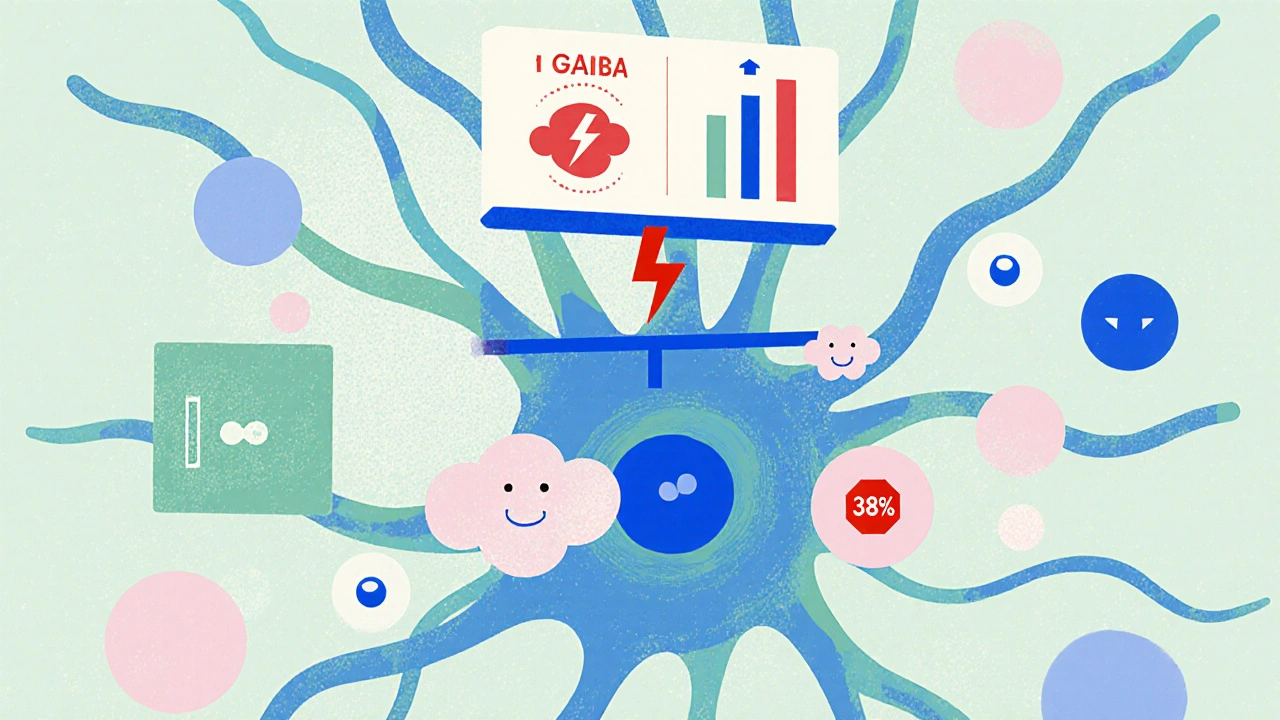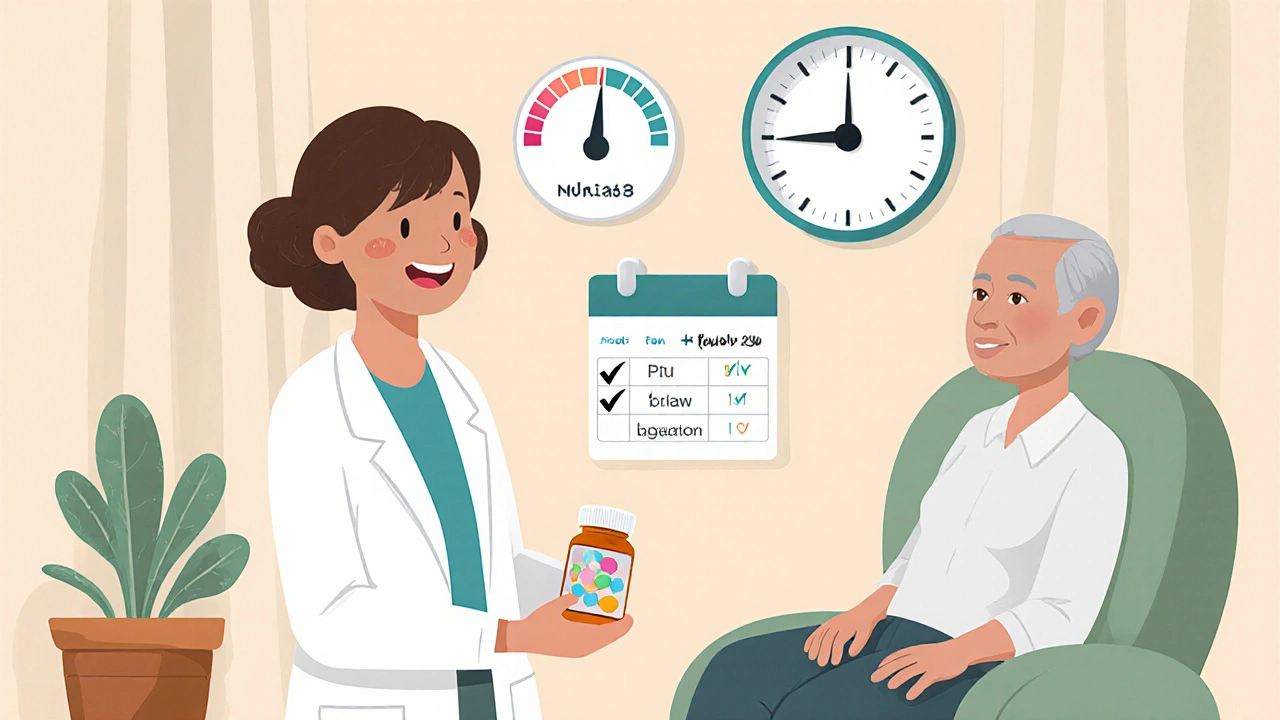Mood Stabilizer Comparison Tool
Compare oxcarbazepine with other common mood stabilizers to understand key differences in mechanism, dosing, side effects, and monitoring requirements.
Select Medications to Compare
Comparison Results
| Parameter | Oxcarbazepine | Lithium | Valproic Acid | Lamotrigine |
|---|---|---|---|---|
| Primary Mechanism | Sodium channel blocker | GSK-3 inhibition, neuroprotective | GABAergic enhancement, histone deacetylase inhibition | Sodium channel blocker (more selective) |
| Approved Indication | Partial seizures | Manic episodes, prophylaxis | Seizures, bipolar disorder | Bipolar depression, maintenance |
| Typical Dose for Mood | 600-2400 mg/day | 600-1200 mg/day | 500-1500 mg/day | 25-200 mg/day |
| Monitoring Required | No | Yes (narrow therapeutic window) | Yes (liver enzymes) | No (but watch for rash) |
| Common Side Effects | Dizziness, hyponatremia | Thyroid, kidney issues | Weight gain, tremor | Skin rash, Stevens-Johnson risk |
| Pregnancy Safety | Category C (caution) | Category D (risk) | Category D (risk) | Category C (caution) |
Ever wondered why a drug originally meant for seizures is showing up in conversations about mood disorders? That’s the story of oxcarbazepine, a medication that’s quietly carving a niche as a mood stabilizer. If you or someone you care about is juggling mood swings, bipolar episodes, or treatment‑resistant depression, understanding how this anticonvulsant works could open a new therapeutic path.
What Is Oxcarbazepine?
Oxcarbazepine is an oral anticonvulsant marketed under brand names like Trileptal. It was first approved by the U.S. Food and Drug Administration (FDA) in 2000 for the treatment of partial seizures. Chemically, it is a keto‑analogue of carbamazepine, meaning it shares a similar backbone but with a slightly altered structure that reduces some of carbamazepine’s notorious side effects.
How Oxcarbazepine Stabilizes Mood
The mood‑stabilizing magic starts at the cellular level. Oxcarbazepine primarily Sodium Channel Blocker activity, which dampens the rapid firing of neurons. By inhibiting voltage‑gated sodium channels, it reduces the excitability of brain circuits that can fuel manic or depressive spikes.
Beyond sodium channels, recent trials suggest oxcarbazepine modulates neurotransmitters tied to mood regulation. It appears to increase GABAergic tone-a calming neurotransmitter-while slightly lowering glutamate, the brain’s primary excitatory driver. The net effect is a smoother, more balanced neural environment, which translates to fewer mood swings for many patients.
Why Consider Oxcarbazepine for Mood Disorders?
Historically, doctors reached for classic mood stabilizers like lithium, valproic acid, or carbamazepine. However, each comes with its own baggage: lithium requires tight blood‑level monitoring, valproic acid can cause weight gain and liver concerns, and carbamazepine is infamous for inducing liver enzymes that interfere with many other meds.
Oxcarbazepine offers a middle ground. A 2022 double‑blind, 12‑month clinical trial involving 324 participants with bipolar II disorder showed that oxcarbazepine reduced depressive symptoms by an average of 38 % and cut the frequency of hypomanic episodes by 27 % compared to placebo. Importantly, the discontinuation rate due to side effects was under 10 %, markedly lower than the 22 % seen with carbamazepine in the same study.
These numbers are encouraging, especially for patients who can’t tolerate lithium’s kidney impact or valproic acid’s teratogenic risk. Oxcarbazepine also does not require routine serum level checks, making it a convenient option for busy lives.

How It Stacks Up Against Other Mood Stabilizers
| Aspect | Oxcarbazepine | Lithium | Valproic Acid | Lamotrigine |
|---|---|---|---|---|
| Primary Mechanism | Sodium channel blocker | GSK‑3 inhibition, neuroprotective | GABAergic enhancement, histone deacetylase inhibition | Sodium channel blocker (more selective) |
| Approved Indication | Partial seizures | Manic episodes, prophylaxis | Seizures, bipolar disorder | Bipolar depression, maintenance |
| Typical Dose for Mood | 600‑2400 mg/day | 600‑1200 mg/day | 500‑1500 mg/day | 25‑200 mg/day |
| Serum Monitoring? | No | Yes (narrow therapeutic window) | Yes (liver enzymes) | No (but watch for rash) |
| Common Side Effects | Dizziness, hyponatremia | Thyroid, kidney issues | Weight gain, tremor | Skin rash, Stevens‑Johnson risk |
| Pregnancy Safety | Category C (caution) | Category D (risk) | Category D (risk) | Category C (caution) |
The table highlights why many clinicians view oxcarbazepine as a “low‑maintenance” alternative: no serum checks, fewer metabolic concerns, and a relatively mild side‑effect profile.
Dosing and Administration Tips
- Start low: 300 mg twice daily for the first week.
- Gradually titrate up by 300 mg every 3‑5 days based on response and tolerability.
- Typical therapeutic range for mood stabilization sits between 600 mg and 2400 mg per day, divided into two doses.
- Take the medication with food to lessen gastrointestinal upset.
- Check sodium levels after 2‑3 weeks, especially in older adults or patients on diuretics.
Because oxcarbazepine can cause hyponatremia (low blood sodium), clinicians often recommend periodic basic metabolic panels. If sodium drops below 130 mmol/L, dose reduction or discontinuation may be needed.

Benefits and Risks: What to Expect
**Benefits**
- Effective reduction in both depressive and hypomanic symptoms.
- Lower risk of serious organ toxicity compared with lithium and valproic acid.
- No routine blood‑level monitoring, which encourages adherence.
- Fewer drug‑drug interactions; it’s a weak inducer of CYP3A4, but not as strong as carbamazepine.
**Risks**
- Hyponatremia - especially in patients >65 years or on concurrent SSRIs.
- Dizziness or somnolence, usually mild and transient.
- Rare rash or hypersensitivity reactions.
- Pregnancy caution - discuss risks vs. benefits with obstetric specialist.
Overall, the safety profile is favorable, but it’s vital to involve a prescriber who can monitor labs and adjust dosing as needed.
Practical Considerations for Clinicians and Patients
When deciding whether oxcarbazepine fits a treatment plan, ask these questions:
- Is the patient already on a sodium‑channel blocker (e.g., carbamazepine) that could be switched?
- Do they have a history of hyponatremia or are they on diuretics?
- Are they pregnant, planning pregnancy, or breastfeeding?
- Do they prefer a medication without regular blood draws?
Answering honestly helps match the drug’s strengths to the individual’s needs. For many, especially those who struggled with lithium’s kidney demands, oxcarbazepine becomes a practical, well‑tolerated option.
Key Takeaways
- Oxcarbazepine is a sodium channel blocker that can smooth out mood swings by calming neuronal over‑activity.
- Clinical evidence supports its use in bipolar II and treatment‑resistant depression, with a lower side‑effect burden than older mood stabilizers.
- Regular monitoring of sodium levels is the main safety precaution.
- Its ease of use-no serum level checks-makes it attractive for long‑term maintenance.
Can oxcarbazepine be used for bipolar I disorder?
Yes, although most research focuses on bipolar II. Clinicians may prescribe it off‑label for bipolar I when patients cannot tolerate lithium or valproic acid. Monitoring remains essential.
How quickly does it work for mood symptoms?
Patients often notice a reduction in anxiety and irritability within 1‑2 weeks, but full mood‑stabilizing effects may take 4‑6 weeks of steady dosing.
Is oxcarbazepine safe to combine with antidepressants?
Generally safe, but watch for hyponatremia when combined with SSRIs such as fluoxetine. Regular labs help catch any electrolyte shifts early.
What should I do if I develop a rash?
Stop the medication immediately and seek medical attention. Although severe skin reactions are rare, they can be serious.
Does oxcarbazepine affect birth control pills?
It can slightly increase the metabolism of hormonal contraceptives, so using a backup method (e.g., condoms) for the first month is recommended.


Write a comment